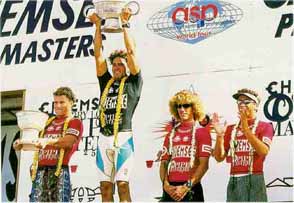|
If all the slang (barrel, snap, etc.) and acronyms (ASP, WCT, WQS) you hear on the beach have you
confused, here's a primer on how the surfers are judged, and how the professional surfing tours work:
Surf contests typically are run like tennis matches: single-elimination pyramids, leading up to four quarterfinals, two semifinals and a final. There are anywhere from two to six surfers per heat, depending on the type of event. In the Triple Crown, most of the events have four surfers per heat, with the top two surfers in each heat advancing to the next round. The men's Pipe Masters and the women's Quiksilver Roxy Pro, which are World Championship Tour (WCT) events, feature two-person heats. (for more on this See: Latest Results
Heats typically last 30 minutes. A surfer is allowed to ride up to 10 waves per heat, though few
surfers will actually catch more than seven or eight waves in the time allotted. The surfer's best three
waves (four in the finals) count. Each wave is judged on a scale of 1 to 10, as in gymnastics or ice
skating. The judging criteria goes something like this: the surfer who performs the most radical
maneuvers--such as riding in the tube (barrel), or turning hard off the top of the wave (snap)--in the
most critical part of the biggest wave will receive the highest score.  All six of the Triple Crown contests are part of the Coca-Cola/Association of Surfing Professionals (ASP) World Tour --the international governing body for professional surfing, and the group that names a women's and men's world champ each year. This year, the tour doled out more than $6 million in prize money. Both the men's and women's ASP tours are divided into two tiers--a World Qualifying Series (WQS) and a World Championship Tour (WCT). The WQS is kind of like the minor leagues, with more than 70 men's events worldwide each year, many of them held simultaneously. The qualifying tour has thriving domestic circuits in such countries as Brazil, Japan, Australia, the U.S. and France. Surfers on the WQS try to earn enough contest points to break into the WCT, which for the men is limited to the 44 best surfers in the world. Only 16 surfers advance from the men's Qualifying Series to the WCT each year; the top 28 surfers on the WCT remain on that tour for another year. Many WCT surfers who don't finish in the top 28 will surf WQS contests in order to requalify, which makes it particularly tough for newcomers to crack the field. The women have a similar structure, but the numbers are smaller. The WCT is comprised of only the top 11 surfers, and each year the bottom five are replaced by the top five women from the WQS. In the end, of course, it's not necessary that you understand the inner workings of the ASP, the WCT or the WQS, or that you even need to know what the initials stand for. You don't even have to understand what a barrel is. If you can get to one of the contest sites on a day when the waves are good, the only thing you really need to know is which way to look: seaward. | ||


